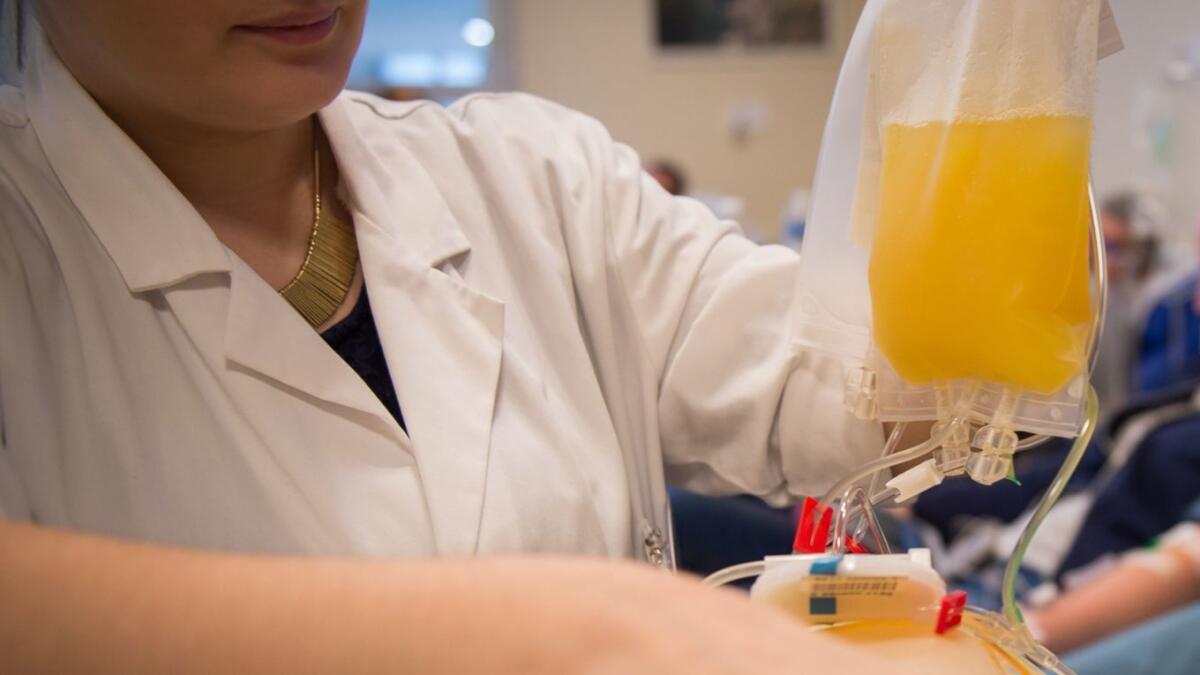This start-up aimed to use transfusions to slow aging. Then the FDA weighed in

- Share via
In 2016, a tiny Bay Area start-up announced an experiment that seemed equal parts medieval sorcery and science fiction: It would inject older people with the blood plasma of young donors in a bid to slow aging.
For three years, Ambrosia Chief Executive Jesse Karmazin charged patients $8,000 to infuse one liter of plasma as part of an unorthodox, crowd-funded clinical trial. Karmazin promised extraordinary results — going so far as to proclaim that his treatment “comes pretty close” to immortality.
Last week, the U.S. Food and Drug Administration poured cold water on his improbable dream. The regulator, echoing individual medical experts, issued a warning saying the treatment’s benefits are unproven and that the practice could be harmful.
“We’re concerned that some patients are being preyed upon by unscrupulous actors touting treatments of plasma from young donors as cures and remedies,” the FDA said, without naming any companies or individuals.
Monterey, Calif.-based Ambrosia — named after the mythical food that conferred immortality on Greek gods — quickly announced that it was ceasing all treatments.
Karmazin didn’t respond to repeated requests for comment after the FDA announcement. Last month, as he planned to open infusion clinics in New York and elsewhere, he explained to Bloomberg the provenance of his start-up and his hopes for success. But now that the federal government has gotten involved, his dream may instead seem like a cautionary tale — one in which America’s perpetual obsessions of youth and technology joined together for one fantastical, and ultimately doomed, moment.
Testing whether young plasma can breathe new life into older patients is fairly unremarkable in the medical world. Scientists have been running controlled anti-aging and rejuvenation tests for a century — but on rodents, not people.
For 150 years, scientists have been stitching together old mice and young mice to enable their blood to pump through each other’s veins. The practice, called parabiosis, often resulted in lab rats contracting infections and dying, and in the 1970s it was largely discarded. But advances over the past 15 years have revived the technique. Nowadays, parabiosis pairs are sniffing around cages in university laboratories across America.
Some studies purport to show the blood of young mice having rejuvenated the aging organs of older mice, making the mice stronger, smarter and healthier. It has even made their fur shinier, other researchers have claimed.
Dr. Gurpreet Baht of Duke University’s Molecular Physiology Institute said he is working with four parabiosis pairs he personally sewed together. He said his research found that fresh blood circulation made the older mice’s blood cells “really act young again,” even healing bone fractures faster than normal. But he was dismissive when it came to claims related to humans.
“We’re still at the level of mouse models,” Baht said. “I don’t think the information is out there for humans. Humans are more complicated.” In 2014, Dr. Saul Villeda of UC San Francisco led a study in which the blood plasma of 3-month-old mice was injected into 18-month-old mice (a mouse’s lifespan is about 2 years). Villeda said the older mice performed significantly better after the infusion. But experts regularly emphasize that in medical testing, mice and humans are decidedly not the same.
Karmazin had just graduated from Stanford University Medical School around the time Villeda’s study was published. Originally from Palm Beach Gardens, Fla., Karmazin said he had long been interested in the “often overlooked” field of aging.
While observing a blood transfusion in an emergency room, Karmazin said, he had his “eureka moment.”
“I was thinking about the [mouse] research and it just occurred to me, like, ‘Wow, transfusions are the same thing for humans,’ ” he said. Karmazin said he dropped out halfway through his residency and founded Ambrosia. On the company’s website, he wrote: “Experiments in mice called parabiosis provided the inspiration to deliver treatments with young plasma.”
Karmazin, 34, wasn’t able to practice medicine because he hadn’t completed his residency. Instead, he said, he partnered with physicians in California and Florida who agreed to perform plasma infusions at their own clinics. Karmazin said he provided them with plasma from donors under the age of 25, purchased from blood banks.
In his interview with Bloomberg, Karmazin said he had treated 150 patients. Their blood was tested in the days before the treatment and one month after it, allowing a comparison of biomarkers. He said he found precancerous cells and amyloids, which indicate Alzheimer’s disease, had fallen by up to 20% post-treatment. He provided no evidence to support the claim.
Karmazin said plasma recipients with Alzheimer’s were “doing their finances again” and others with “severe heart disease” were able to run up stairs. He didn’t provide any evidence for those claims either. Karmazin said he planned to publish the results once they were peer-reviewed, but he didn’t say where, or who was doing the reviewing.
One 62-year-old from Southern California said in a telephone interview arranged by Karmazin that he had been receiving infusions for more than a year. He is only the second person to speak publicly about his treatment by Ambrosia. The man, a mathematician who requested anonymity to protect his medical privacy, said a motorcycle accident in 2011 had left him partially paralyzed. After the infusions, he said, he could sleep through the night again and generally felt better.
Leading researchers in the regenerative medicine field strenuously reject Ambrosia’s premise.
“Those [mouse] studies don’t provide a scientific basis for what Ambrosia is offering,” said Dr. Amy Wagers, co-chair of the Harvard Department of Stem Cell and Regenerative Biology. Parabiosis conjoins an entire organ system, whereas plasma infusion is just one element, she said.
“The research we are doing can be sensationalized,” said UC San Francisco’s Villeda. “In order to avoid hoax studies we need appropriate clinical trials.”
Such trials are completed in controlled environments and governed in part by federal guidelines. Companies must meet a set of standards before making any health claims. However, Karmazin didn’t need the FDA to approve his trial because he was offering a pre-approved procedure — a basic blood infusion — as an off-label treatment. Still, he sought approval from the Institute of Regenerative and Cellular Medicine’s Institutional Review Board, an independent group that determines whether a study on human subjects is ethical.
Dr. Barbara Krutchkoff, co-chair of the institute’s Institutional Review Board and a consultant in biomedical studies, said she signed off on Karamzin’s study because it was a medically approved procedure and “nothing out of the ordinary.”
“People have done weird things over the years to think they could become younger, and this was not the weirdest,” she said, adding that critics of her decision have said, “Who do you think you are, allowing him to do this?”
“Some people spend $8,000 to go to the Super Bowl,” Krutchkoff said. “If you want to spend $8,000 to get a young person’s blood transfusion and it feels good, then why the hell not?” Overall, she said, the treatment is “no more dangerous than walking across the street.”
Human longevity has been a popular topic in Silicon Valley. Billionaire tech entrepreneurs such as Peter Thiel, Y Combinator President Sam Altman and Tesla CEO Elon Musk have been pouring money into bioengineering start-ups. The tech industry’s desire to cheat death was even lampooned in a 2017 episode of HBO’s “Silicon Valley.” The TV comedy showcased human-to-human parabiosis, with a young “blood boy” directly transfusing his blood into a wealthy, aging recipient.
Despite the obvious appetite for holy grail start-ups, when Karmazin came knocking, venture capital firms didn’t answer. “It’s been somewhat difficult to raise money,” he said. “I’ve talked with a number of potential investors, but we haven’t raised money at this point.” He blamed it on people being “squeamish” about blood.
As 2019 began, Karmazin said he was excited for the future. He described plans to open a clinic in New York because it’s an “affluent place where people can afford it,” and possibly Texas and Ohio soon after.
In their warning, FDA Commissioner Scott Gottlieb and Peter Marks, head of the agency’s biologics center, wrote they had become aware of people “charging thousands of dollars for infusions that are unproven and not guided by evidence from adequate and well-controlled trials.”
“We will consider taking regulatory and enforcement actions against companies that abuse the trust of patients and endanger their health with uncontrolled manufacturing conditions or by promoting so-called ‘treatments’ that haven’t been proven safe or effective for any use,” the regulator said. Hours later, the Ambrosia website was updated to say: “In compliance with the FDA announcement issued Feb. 19, 2019, we have ceased patient treatments.”
Karmazin didn’t make any public statements afterward. Krutchkoff said Karmazin told her that he was going to “put everything on hold.”
This comes as a relief to Dr. Irina Conboy, a rejuvenation researcher at UC Berkeley. She said she has had concerns about Ambrosia for years. Plasma infusion is typically reserved for life-threatening situations, Conboy said, because it can trigger serious side effects, such as allergic reactions, circulatory overload, lung injury and infectious disease transmission.
In 2016, she published a paper on mice-to-mice blood transfusions. She said Karmazin called her office and left a voicemail message saying that he enjoyed her research and that it fell into line with the treatment he was providing at Ambrosia. In the message, she said, he asked if they could work together. Conboy said she never returned his call.
For Conboy, the most frustrating part of the Ambrosia saga is that it tarnishes the area of regenerative medicine, where she said scientists are on the brink of groundbreaking discoveries that could truly help ailing elderly patients.
“Do not inject yourself with blood,” she said. “Wait a couple of years until we have a safe and rational treatment based on science.”
More to Read
Inside the business of entertainment
The Wide Shot brings you news, analysis and insights on everything from streaming wars to production — and what it all means for the future.
You may occasionally receive promotional content from the Los Angeles Times.










